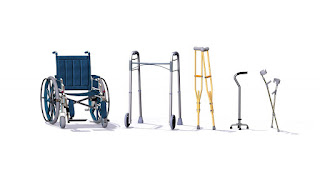Making it "Fit"
Please give at
least two reasons
for the importance of appropriately "fitting" your patient for use of an
assistive device. Next, please explain how you would accomplish
this for a cane,
axillary crutches, Lofstrand crutches, platform walker, and a rolling
walker.
Making sure that the patient’s assistive
device “fits” properly is imperative; it ensures comfortability, it improves
posture, it increases stability and balance, and takes pressure off certain nerves
and muscles. Canes and walkers would be an example of devices that should fit
properly. As we know, these two devices assist people who may have instability
or weakness in certain muscles or bones. A way to guarantee that the devices are
customized and comfortable for the person is to make sure that the hand grip is
at the level of client’s ulnar styloid, wrist crease, or greater trochanter. If
not carefully and properly customized, the hand grip could essentially put
pressure on the flexor retinaculum; making the client more susceptible to
carpel tunnel syndrome and tendinitis of the wrist.
Crutches would also be considered an assistive
device. They are used if a client has
lost a limb or has a lower extremity impairment. When assigning crutches, the clinician
should always make sure that the shoulders are relaxed; then they should
measure and reassure that the axillary rest is 5 cm below the floor of the
axilla. If not fitted properly, it can cause major discomfort under the arm and
also may make the client more prone to pressure sores, due to the constant
pressure contact beneath the arm.
Another
device that should always be fitted properly are wheelchairs. It is important
that the size of the wheelchair be proportional with the person. The seat’s width,
length, and height should all be sized for the comfort of the client. When
measuring the width and height, the therapist should always add two extra
inches just to ensure comfort and room to move. When measuring the height,
however, the clinician should subtract two inches. This is done to make sure
that the posterior leg is not rubbing against the wheelchair and to allow the
leg to swing (if able).

Nice job! I appreciate the addition of the information about wheelchairs.
ReplyDelete